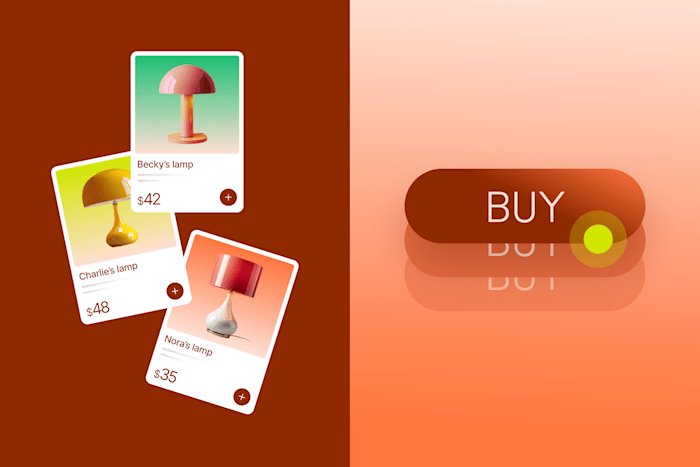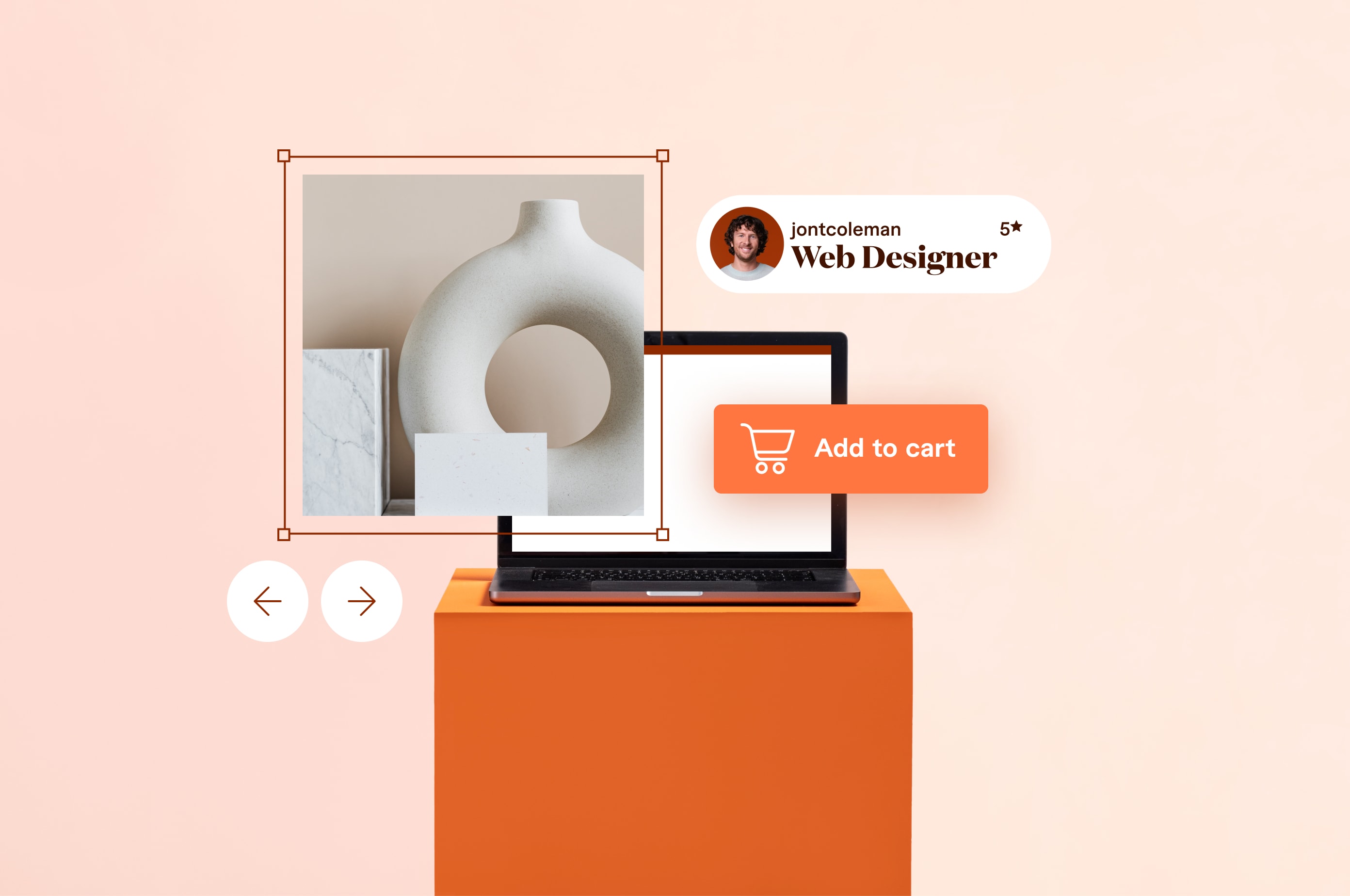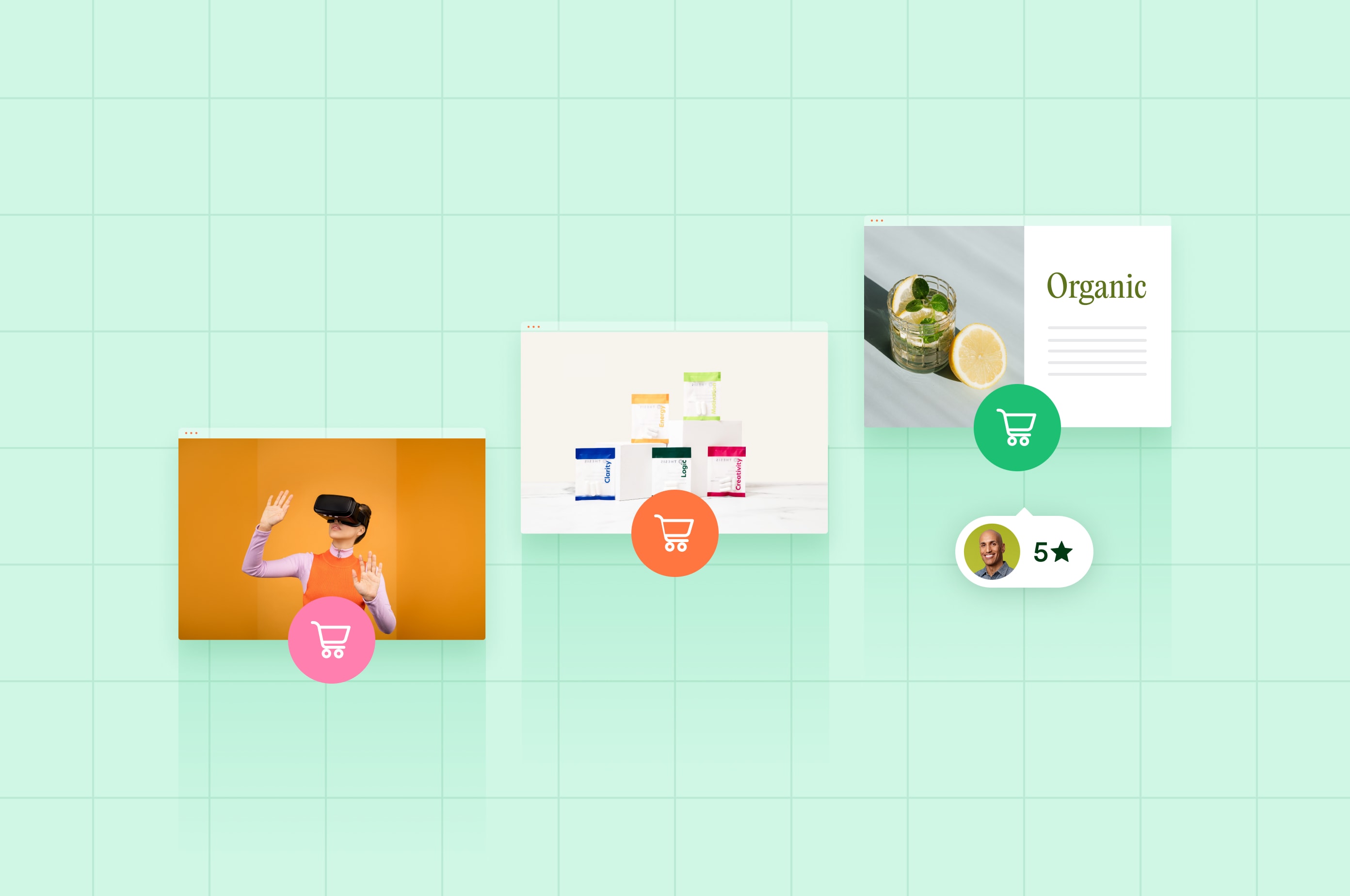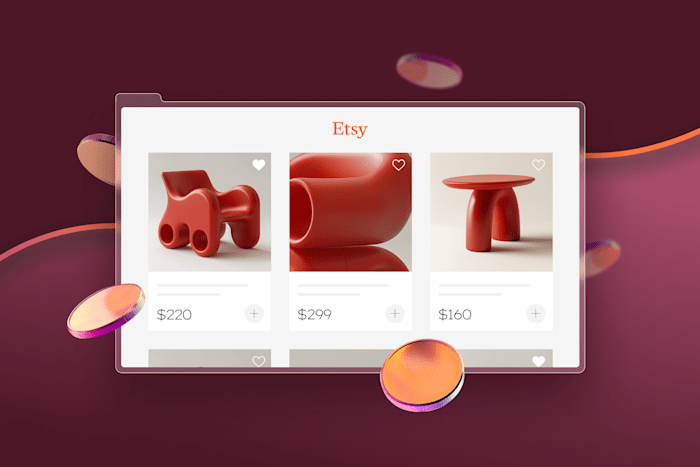How to Sell Online in 9 Simple Steps (2025)
Want to master the art of selling online? This guide is your one-stop resource for all the tips and strategies you need to succeed as a new entrepreneur in the digital marketplace.
 December 5, 2024
December 5, 2024 16 minute reading
16 minute reading
In the early days of the internet, selling products online was a complex endeavor, often requiring a physical store presence. Despite the emergence of pioneers like Amazon in the 1990s, consumers largely preferred the familiar experience of in-person shopping.
The landscape began to shift dramatically in the mid-2010s, with e-Commerce gaining significant traction. By then, 8 out of 10 Americans were embracing online shopping. Fast forward to 2024, and we've witnessed a remarkable evolution: not only can we shop online with ease, but selling products in the digital marketplace has become accessible to almost anyone.
However, for new entrepreneurs, the prospect of setting up an online store can still feel overwhelming and time-consuming. This guide aims to simplify that process. We'll walk you through the essential steps of selling products online and share valuable tips to help you succeed in the digital marketplace.
What do you need to sell online?
Before you can sell online, there are a few basics to cover.
Craft a brand
A brand is the identity and personality of your business. It encompasses your values, voice, visuals, and overall customer experience. For online businesses, a strong brand is crucial as it:
Differentiates you from competitors
Builds trust and recognition
Creates emotional connections with customers
When deciding on your branding, consider:
Your target audience and their preferences
Your unique selling proposition
Your business values and mission
Aim for consistency across all touchpoints, from your logo and color scheme to your communication style. Your brand should resonate with your ideal customers and reflect what makes your business special. A well-defined brand can turn one-time buyers into loyal, long-term customers.
🧰 Create your logo in minutes with Fiverr’s Logo Maker. Get a brand style guide, social media designs, and more to create a memorable brand everywhere.
Build a website
A website serves as your digital storefront in the online marketplace. It's where potential customers discover your products, learn about your brand, and ultimately make purchases. A well-designed website showcases your offerings and provides a seamless shopping experience.
As an online seller, your website is available 24/7, so customers can shop anytime. It also presents your brand to the world.
When creating your website, focus on these key aspects:
User-friendly design and navigation
Mobile responsiveness
Clear product descriptions and high-quality images
Secure and easy checkout process
Your website often gives a customer's first impression of your business. Make it count by ensuring it's functional, engaging, and reflective of your brand identity. A great website can differentiate between a bounced visitor and a loyal customer.
Streamline shipping and order fulfillment
Shipping and fulfillment is getting products to your customers' doors. If you’re just selling digital products, you don’t have to worry much about shipping.
Traditional shipping involves storing inventory and handling order fulfillment yourself or through a third-party logistics provider (3PL). This method offers control over the entire process but requires more upfront investment and management.
Dropshipping, in contrast, is a fulfillment method where you don't keep the products you sell in stock. Instead:
You partner with a supplier who holds the inventory
When a customer places an order, you forward it to the supplier
The supplier ships the product directly to the customer
However, it also comes with challenges, such as less control over quality and shipping times, potentially lower profit margins, and more competition.
Your shipping and fulfillment strategy should align with your business goals and customer expectations. Be prepared to adapt as you grow and as market conditions change. With the right approach, shipping can go from a necessary cost into a powerful tool for customer satisfaction and business growth.
Execute effective marketing strategies
Marketing is what gets the word out about your online store. It raises awareness for your brand and drives organic traffic to your website, which can result in more sales. A good marketing strategy includes a mix of channels, like:
Content marketing (blogs, videos, podcasts)
Paid advertising (PPC, display ads)
The key to successful marketing is understanding your target audience and crafting messages that resonate with them. Tell your brand's story, showcase your product's benefits, and create value for your customers beyond just selling to them.
Don't be afraid to get creative and experiment with different marketing tactics. Maybe you start a TikTok challenge related to your products or collaborate with influencers in your niche. The digital world offers endless possibilities for innovative marketing approaches.
Types of products to sell online
You can sell almost anything on the internet these days. Overall, products often fit into one of three categories:
Physical goods
Many online businesses sell physical goods, which include a wide range of products that customers can touch, feel, and use in their everyday lives.
Some popular categories include:
Electronics (smartphones, laptops, smart home devices)
Clothing and accessories (t-shirts, jewelry, handbags)
Home and garden items (decor, kitchenware, furniture)
Beauty and personal care products (skincare, makeup, haircare)
Fitness equipment (yoga mats, dumbbells, resistance bands)
You’ll source or manufacture these products yourself. The key to thriving with physical goods is finding reliable suppliers and having a good shipping process. New online sellers typically work with dropshipping partners to manage inventory and fulfillment.
Digital products
Imagine a storefront that never closes, where shelves restock instantly, and products travel at the speed of light. Welcome to the world of digital products. With digital products, creators and entrepreneurs can turn their expertise into a valuable asset that can be shared globally with just a few clicks. From the aspiring author who publishes their first book to the seasoned programmer launching a new app, digital products offer a platform for diverse talents to shine. Popular products you can sell in this category include:
E-books and digital publications
Online courses and tutorials
Software and applications
Digital art and designs
Music and audio files
Templates and themes
The beauty of digital products lies in their versatility and accessibility. A photographer in Tokyo can sell her Lightroom presets to a budding artist in Brazil, or a fitness guru in Australia can guide followers through workout routines in Canada.
Selling digital products eliminates many of the logistical challenges associated with physical goods. There's no need for inventory management or shipping, and your products can be duplicated infinitely without additional production costs.
Services
Selling services online is a low-cost and easy way to enter the market. Skills, expertise, and time are the commodities, and your possibilities are as limited as human talent itself.
The types of services you could offer online are:
Creative services (graphic design, content writing, video editing)
Professional services (consulting, legal advice, financial planning)
Technical services (web development, IT support, data analysis)
Educational services (tutoring, language lessons, professional training)
Wellness services (online therapy, fitness coaching, nutrition planning)
Virtual assistance (administrative tasks, customer service, social media management)
What makes the service sector unique is its personal nature. Unlike physical or digital products, services are often tailored experiences, crafted in real-time through direct interaction between provider and client.
How to sell online, step-by-step
Selling online involves more than just listing products and waiting for sales. It requires careful planning, strategic decisions, and execution across multiple areas— from setting up your store to marketing and customer service.
While navigating this process alone can be time-consuming and costly, platforms like Fiverr offer a shortcut by connecting you with experts in every aspect of e-Commerce. Whether you're a novice or looking to expand your online presence, this guide will walk you through the essential steps to successfully sell online.
Step 1: Conduct market research to find a niche
Selecting the right market is crucial for the success of your e-Commerce venture. This step involves leveraging your industry experience or conducting thorough market research to identify profitable product categories. Both approaches have their merits and can lead to successful outcomes.
Find a market research specialist for hire
If you're drawing from your industry experience, it's essential to critically evaluate your chosen niche. Consider the following key questions:
What’s an underserved market in your niche?
What are the current needs of customers in that market?
Do you have the resources to create a novel product?
How in demand is your product category right now?
What’s the purchasing power of your customer base?
How profitable can this market segment or product idea be?
These questions will help you gauge the potential of your chosen market and guide your product selection process. They encourage you to consider market gaps, customer needs, resource requirements, demand levels, target audience, and profitability.
For those without specific industry experience, conducting comprehensive market research is the way to go. Start by exploring popular e-Commerce platforms to identify trending products.
For instance, Amazon's "Best Selling" section provides valuable insights into popular products across various categories.
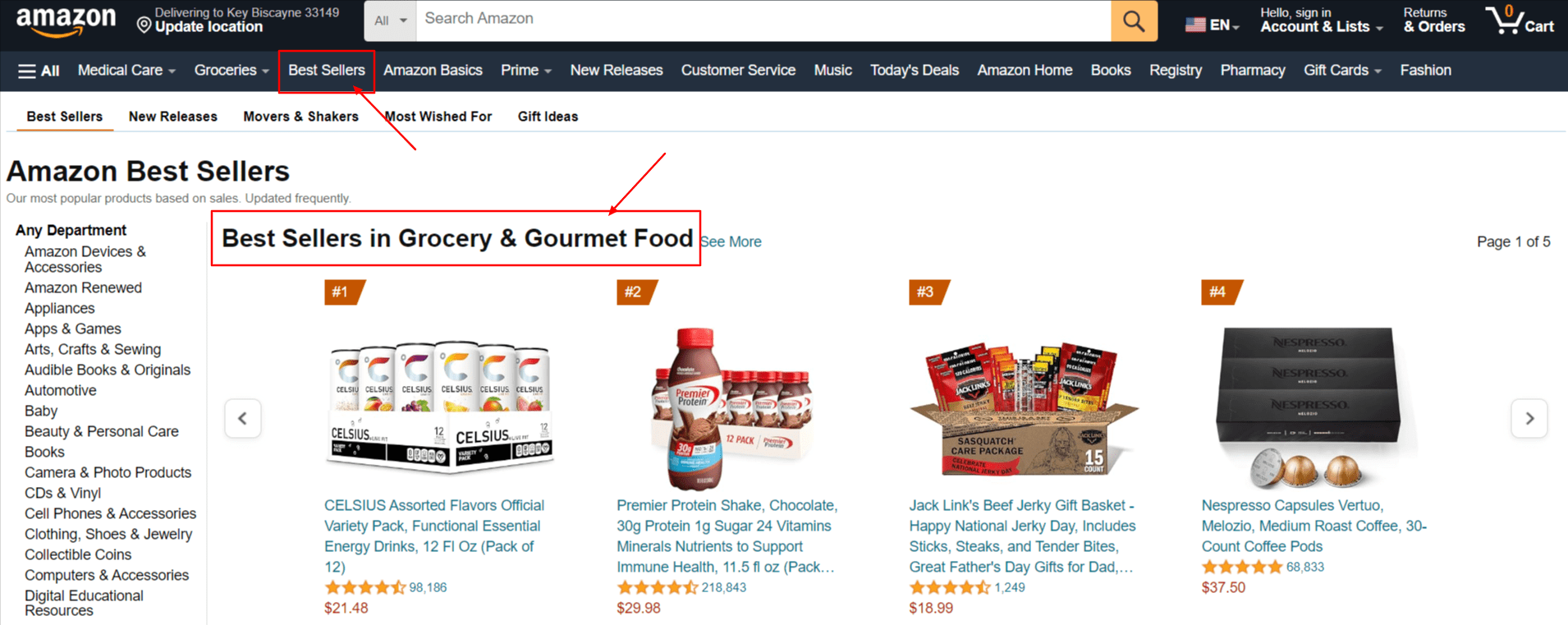
Amazon’s Best Selling products online (Source)
To gain deeper insights, consider surveying or directly engaging with potential customers in your target segment. This approach allows you to uncover specific needs, consumption patterns, demographics, and buying habits. The data gathered from this research will inform all your subsequent decisions, from product development to marketing strategies.
Step 2: Choose which products to sell
Start by brainstorming product ideas that fit within your chosen market niche. Consider your interests, expertise, and observations of market trends.
Look for gaps in the market or common pain points that your products could address. For instance, if you're in the fitness niche, you might notice a lack of eco-friendly yoga mats or innovative home workout equipment.
You can use product research tools to find new ideas, like:
Jungle Scout: Provides sales estimates, keyword data, and product tracking for Amazon listings.
Helium 10: Offers a suite of tools for product research, keyword tracking, and profitability analysis.
Once you have a list of potential products, evaluate each option based on several key criteria:
Demand: Is there a consistent or growing demand for this product?
Profitability: Can you source or produce the item at a cost that allows for a healthy profit margin?
Competition: How saturated is the market for this product? Can you offer something unique?
Practicality: Consider size, weight, and durability for shipping and storage.
Seasonality: Will the product sell year-round or only during specific seasons?
After this evaluation, narrow your list to some of the most promising products. Consider starting with a small, focused selection rather than a wide array of items. This allows you to test the market and refine your offerings based on customer feedback.
Step 3: Decide where to sell your products
Next, decide where you want to sell your products. While having your own e-Commere store offers maximum control, leveraging third-party marketplaces can provide early traction and exposure with a low budget. Popular options include:
Major marketplaces: Platforms like Amazon, Etsy, eBay, Walmart are popular choices that offer vast audiences and built-in traffic. These are excellent for reaching a wide customer base quickly.
Specilized platforms: Alibaba (ideal for wholesale), Target, and BestBuy (focused on electronics) cater to specific markets or product types. These platforms can help you reach a more targeted audience if your products align with their niches.
Local selling: Platforms like Craigslist and Facebook Marketplace are perfect for quick, local sales without shipping costs. However, they typically offer limited reach compared to global marketplaces, making them ideal for selling larger items or testing market demand locally.
These platforms typically require a seller account with details such as:
Personal and business information
Government-issued ID and tax details
Contact information and bank account details
Product specifics
Note that, unlike building an e-commerce website, which comes with significant costs, third-party marketplaces typically come with very low to no upfront fees. With most, It's free to list your items, and you only pay a fee if your item sells.
However, there may be costs associated with subscription plans and with advertising or promoting your listings, which can cut into your profits.
If you prefer to build your own website, e-Commerce platforms like Shopify, WooCommerce, or Magento offer user-friendly solutions.
Shopify provides an all-in-one system with built-in payment processing and customizable themes, which are ideal for businesses of all sizes. WooCommerce, a WordPress plugin, is free but may require additional technical expertise.
🧠 Learn: 13 Best Ecommerce Platforms For Small Businesses in 2024
Consider your budget, technical skills, and business needs when choosing your selling platform. Each option has pros and cons, so evaluate them carefully to find the best fit for your e-Commerce venture.
Step 4: Set up your online store
Picture your online store as a digital storefront, inviting customers to easily browse and buy. Creating this virtual shop requires careful planning and execution.
Begin by laying the groundwork: secure a domain name that reflects your brand, legally register your business, and open a dedicated bank account. These steps establish your store's foundation in both the digital and physical worlds.
Now, it's time to build your store. Most e-Commerce platforms offer user-friendly tools for this crucial stage. Focus on creating these essential pages:
Homepage: Your digital front door, showcasing your brand story and featured products.
About Page: Share your company's history, values, and mission to connect with customers.
Product Pages: Detailed, visually appealing pages for each item, including descriptions, pricing, and high-quality images.
Category Pages: Organize your products into intuitive groups for easy navigation.
Contact Page: Provide multiple ways for customers to reach you, building trust and accessibility.
Policies Pages: Clearly outline your shipping, returns, and privacy policies to set customer expectations.
Tentree, for example, has an excellent homepage. It immediately captures attention with a lifestyle image that resonates with the target audience, showcasing people enjoying outdoor activities while wearing the brand's products.

Tenntree’s homepage is a great example of an effective homepage
The clean layout, clear navigation menu, and prominent "BACK TO ROUTINE" message with accompanying text effectively communicate the brand's focus on outdoor and everyday wear.
Its product pages also provide clear, high-quality images of products along with comprehensive product information, including color options, sizes, and a detailed description.

The page's layout is user-friendly, with easy-to-find essential details like price, color selection, and size guide, while additional sections for product details, size and fit, and shipping information allow customers to make an informed purchase decision.
Most e-Commerce platforms provide user-friendly tools that simplify building your online store, offering customizable templates and intuitive interfaces for easy setup.
To launch your website, you'll need to focus on adding your unique elements: uploading your product catalog, crafting compelling copy that reflects your brand voice, and incorporating high-quality images that showcase your offerings effectively.
Step 5: Source products from multiple sources
The next step is to find reliable suppliers. Begin by researching local retailers in your area. These businesses often offer competitive rates and may help reduce manufacturing costs.
You may need to source from other partners as well. Some methods include:
Wholesale purchasing: This involves buying products in bulk directly from manufacturers or distributors at discounted prices. While it provides better control over inventory, it requires a larger upfront investment.
Manufacturing your products: If you have a unique design or innovative product, consider manufacturing it yourself or setting up a small factory. This method offers complete control over design and quality but may require significant initial investment.
Dropshipping: With this method, you don't handle inventory. Instead, you connect with a supplier who ships products directly to your customers. While it requires less upfront capital, it often comes with lower profit margins and less control over shipping.
Private label manufacturing: Partner with a product supplier to white-label their products with your branding. This option is ideal if you want to sell branded items without sourcing manufacturers yourself.
To find reliable suppliers, attend industry trade shows, use online directories, and leverage your professional network. When evaluating potential partners, consider their reputation, product quality, pricing, and ability to meet demand. Remember, the goal is to find suppliers who align with your business values and can consistently deliver quality products.
Step 6: Create a pricing and shipping strategy
Determining your pricing strategy requires careful consideration of multiple factors. Calculate your total costs, including the cost of goods, marketing expenses, platform fees, packaging, shipping, employee wages, and taxes. Aim for a profit margin between 10% to 15% to ensure your business remains viable.
Consider various pricing models to attract and retain customers. Penetration pricing, where you initially offer lower prices to gain market share, can be effective for new businesses. As you establish your brand, you might transition to bundle deals, volume discounts, or subscription-based pricing to maintain steady revenue.
Shipping costs can significantly impact your pricing strategy. You have several options:
Pass the exact shipping cost to the customer, clearly stating this on the product page
Offer free shipping above a certain order value to encourage larger purchases
Use tools to show customers how close they are to reaching a free shipping threshold
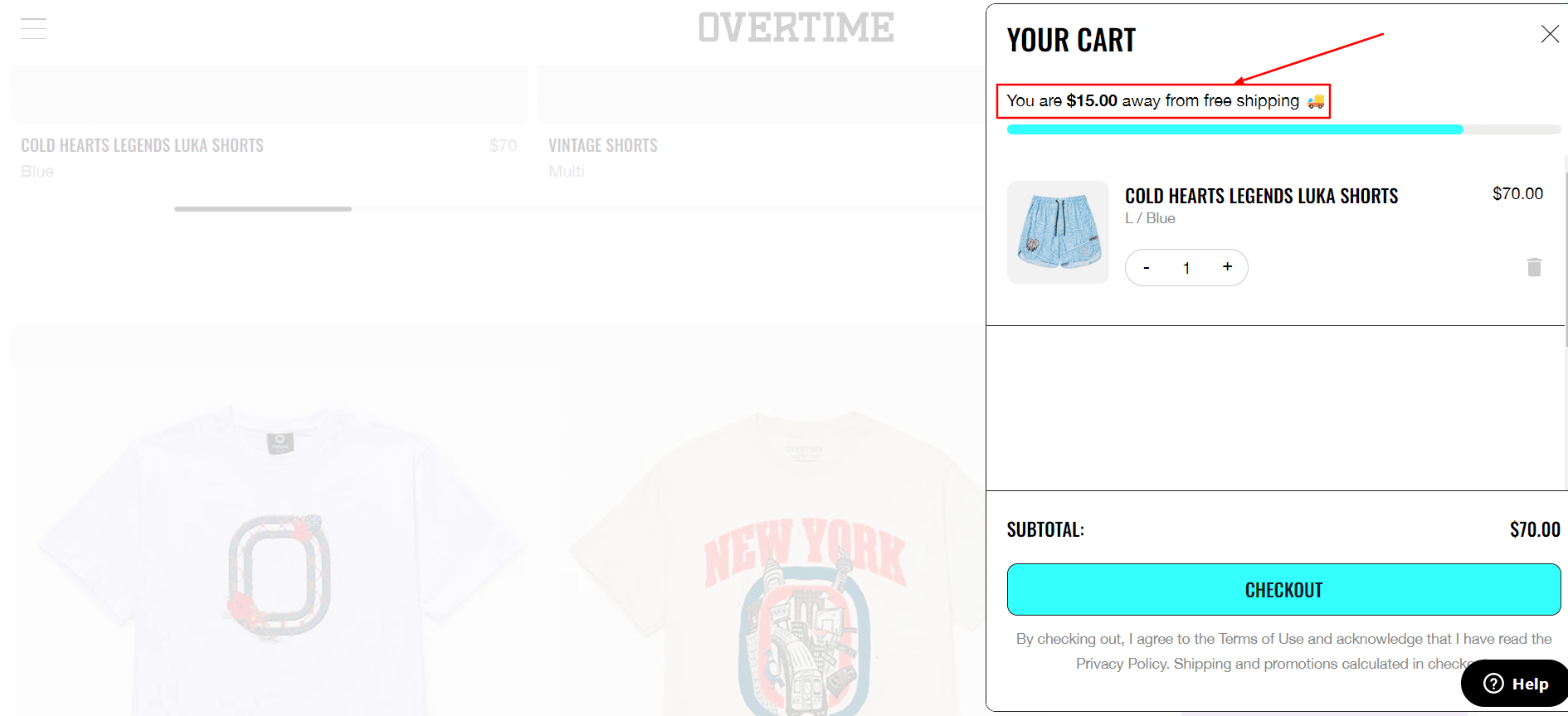
Overtime encourages shoppers to add items to the cart by showing them how much they need to get free shipping (Source)
For tax considerations, charge based on your customer's location. For international orders, use services like Stripe or Shopify Payments that can automatically calculate and apply appropriate taxes at checkout.
Step 7: Start marketing your online store
Ready to launch? Well, not yet. Nobody knows about your store, which means it’s time to invest in different channels to gain some traction.
Roman Zrazhevskiy, founder and CEO of MIRA Safety, a protective equipment store, recommends starting on multiple social media platforms. She explains, “Select a mix of platforms that allow you to target customers with varied media preferences.”
“Pinterest is excellent for customers who love browsing through product imagery, while Instagram and TikTok suit audiences interested in developing more familiar relationships with brands before they decide to buy.”
With the number of stores coming up these days, you need to maximize your surface area of luck. Here are a few proven channels to consider:
Search engine optimization (SEO)
This is one of the most critical aspects of marketing because the sooner you get started, the better. To improve your store's visibility in search engines, optimize your website’s content, structure, and metadata for relevant keywords. For example, if you’re selling protective gas masks, optimize for keywords like “protective gas masks” or “gas mask store in [location].”
Leena Chitnis, founder of Timberdog, a dog bed store, says that, “Initially, I did not have money, so I built my store through organic SEO via link insertions, backlinks, guest blog posts, and more. Organic SEO is more powerful in the long term because it ensures you have evergreen links, bringing traffic and raising your domain authority and trustworthiness as a seller. SEO makes you legit.”
Social media marketing
Consider channels like Facebook, Instagram, and TikTok to market your store. You need to share engaging content that shows your product’s capabilities and encourages people to follow you. For example, Timberdog recently conducted a giveaway contest to encourage people to follow the brand on Instagram.

A giveaway contest by Timberdog on Instagram (Source)
Email marketing
Build an email list by offering incentives to sign up, such as discounts or early access to products. You can also use this list to send newsletters and occasional promotions over time. The best way to capture these emails is to add a pop-up on your website and blog pages.
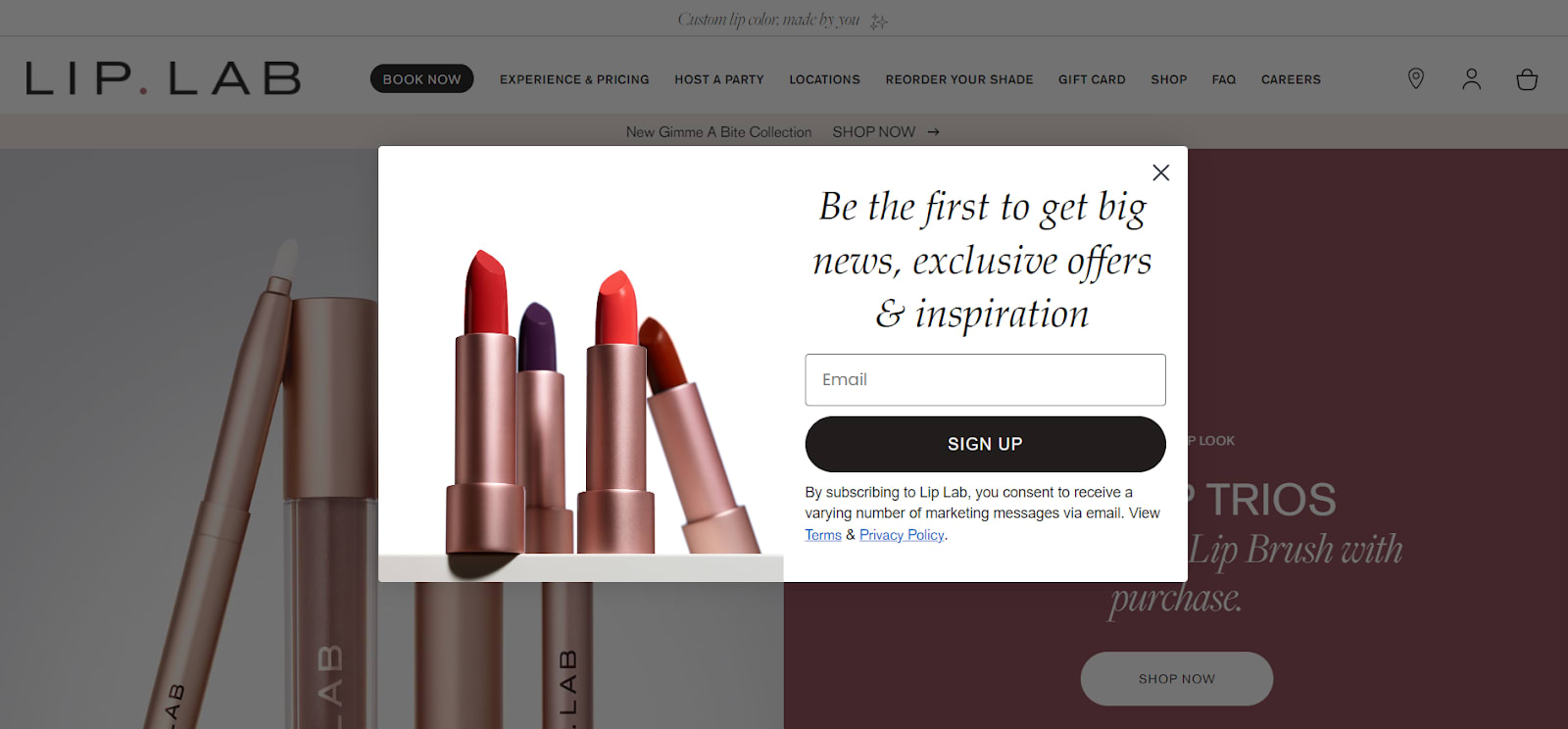
Example of an email capture form by Lip Lab (Source)
🧠 Learn: How to Do Email Marketing: A Complete Guide
Paid ads
Paid advertising can be a powerful tool to kickstart your online sales and increase brand visibility.
While organic growth is valuable, paid ads offer a faster route to reaching potential customers. Focus on platforms where your target audience spends their time, such as Facebook, Instagram, and Google.
When creating your paid ad campaigns, consider the following key elements:
Audience targeting: Use demographic data, interests, and behaviors to narrow your audience.
Ad creatives: Develop eye-catching visuals and compelling copy that resonates with your target market.
Landing pages: Ensure your ads lead to relevant, optimized pages on your website.
Budget allocation: Start small and gradually increase your spending as you learn what works best.
Monitor your campaigns closely and analyze the data regularly. Look at click-through rates, conversion rates, and return on ad spend. Use this information to refine your targeting, adjust your ad creatives, and optimize your overall strategy.
Step 8: Set up a customer service strategy
Before you get bombarded with queries, have clear customer service policies in place. Set up a returns and shipping policy page and provide an email address for customers to contact you.
Consider implementing an e-Commerce chatbot to handle common queries efficiently. This AI-powered assistant can provide instant responses on shipping, returns, and product information, freeing up your human support team for more complex issues.
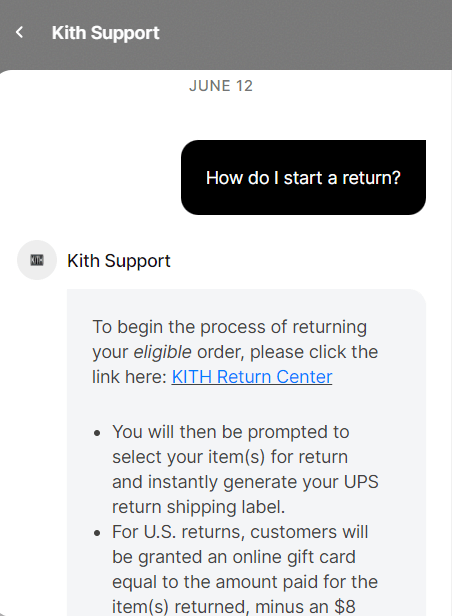
Example of a customer service chatbot (Source)
As your business grows, hire a dedicated customer support professional to manage nuanced interactions and provide a personal touch.
Regularly seek customer feedback through post-purchase surveys and review platforms to identify areas for improvement and build customer loyalty.
Step 9: Keep analyzing and optimizing your store
Continuous improvement is the only way to build a store that will last years. Take the initiative to analyze your store’s performance regularly.
Review customer feedback to identify areas where your store or products may fall short. This insight is invaluable for making targeted improvements to your business.
Next, focus on optimizing your operations. Work closely with suppliers and logistics partners to tighten up inefficiencies in your supply chain. Analyze your sales data to identify trends and popular products, adjusting your inventory accordingly. This data-driven approach ensures you're always stocking items your customers want.
Keep a watchful eye on both new and established competitors. Use this information to optimize your pricing strategy and stay competitive. Additionally, leverage tools like Google Analytics to review your marketing campaign data. This helps you understand your audience's needs and preferences and tailor your marketing efforts more effectively.
Build your own online store with Fiverr’s ecommerce experts
Success in e-Commerce requires patience and adaptability. Stay attuned to your store's performance and market trends, and be ready to pivot quickly when necessary. You can build a thriving online store with persistent effort and a willingness to learn.
Instead of spending time on the execution side, hire freelance professionals on Fiverr. You could hire professionals like:
Market research assistants help identify your target audience and competitors to provide insights that guide strategic decisions for positioning your online store effectively, ensuring your store meets market demands.
Product research assistants find trending profitable products with high potential, by analyzing trends, customer preferences, and market gaps to optimize your offerings for profitability.
Ecommerce branding develops and implements a consistent brand identity, including logos, messaging, and visuals, to create a memorable and trustworthy image for your online store, making it stand out in a crowded market.
Ecommerce website developers integrate the brand's identity into the store's design and functionality, ensuring that the website visually reflects the brand and provides a seamless user experience.
Ecommerce marketing drives traffic to your store through strategic content and campaigns, increasing visibility and sales.
Ecommerce advertising targets potential customers with paid ads, boosting your store's reach and attracting more buyers.
These experts have experience building thriving ecommerce businesses and can get up and running quickly. If you’re ready to hire an ecommerce partner, sign up for Fiverr today.
How to sell online FAQ
What is the best method for selling online?
The best method depends on your industry and business needs. Some popular methods include:
Setting up your ecommerce website using platforms like Shopify, WooCommerce, or Magento
Selling on marketplaces like Amazon, eBay, or Etsy
Using social media platforms like Facebook or Pinterest to sell directly to your followers
Using a dropshipping model, where products are shipped directly from the manufacturer to the customer
What is the best site to sell products online?
There are several websites these days that let you sell products with ease. Some of them include:
Amazon: Ideal for reaching a broad audience and leveraging a trusted platform
Etsy: Perfect for selling handmade, vintage, or unique items
eBay: Great for selling a wide variety of products, both new and used
Shopify: An ecommerce platform that lets you set up a store
WooCommerce: An open-source platform that integrates with WordPress websites
How can I sell online for free?
No matter where you sell your products, there will be a cost. For example, if you use a platform like Shopify, you’ll have to pay a subscription fee and payment processor fees. Or if you’re selling via Instagram, you’ll have to pay for shipping and ad costs. You can reduce the cost of selling if you limit inventory or source products for a low price.
What is the best platform to sell online for beginners?
If you’re a beginner, use a platform like Shopify, which offers a user-friendly interface, an extensive list of integrations, and reliable customer support. If you want a simpler store, you can build one using Wix and connect a payment processor.
